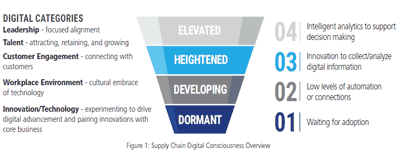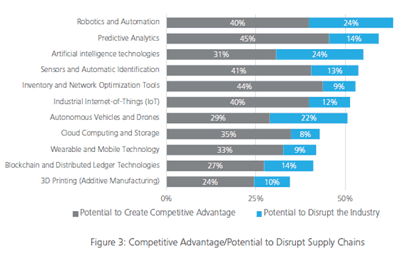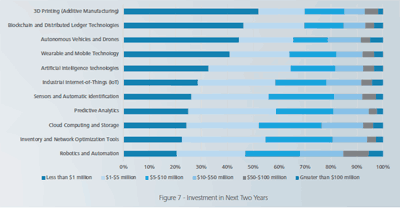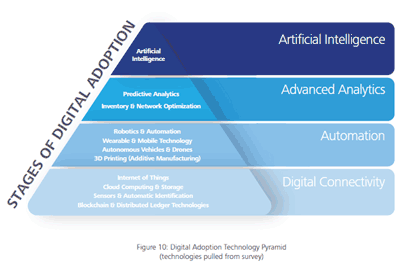 |
August 2, 2019 - Supply Chain Flagship Newsletter |
 |
|
|||||||||||
 |
|
|||||||||||||||||||||||||||||||||||||||||||||||||||||||||||||||||||||||||||||||||||||||||||||||||||||||||||||||
|
||||||||||||||||||||||||||||||||||||||||||||||||||||||||||||||||||||||||||||||||||||||||||||||||||||||||||||||||
The report really kicks off with a series of charts representing survey results. As I have opined many times in the past, the overwhelming tendency is to define supply chain digitization as a sum of a laundry list of new technologies, from drones to artificial intelligence. So among the many charts I will grab this one, which shows the percent of respondents that believe the impact of different technologies to either create competitive advantage or disrupt supply chains. |
||||||||||||||||||||||||||||||||||||||||||||||||||||||||||||||||||||||||||||||||||||||||||||||||||||||||||||||||
Robotics and related automation tops the list, and I think that is probably right - as I have written many times, we have entered the robotic era. I am somewhat obsessed with interpreting this kind of data correctly, and to that end will note that of the listed technologies, 3D printing ranked at the bottom of the list. But you have to put that in context. Does the average retailer or wholesaler likely see much opportunity in 3D printing? Probably not. So across all respondents, it scores relatively low. But I think 3D printing actually provides a incredible opportunity to disrupt current manufacturing paradigms, with potentially a seismic impact in some areas on logistics. The report then looks at the amount of real money respondents that say their companies are going to invest in each of these technologies over the next two years. Those plans are somehow summarized in the chart below, which I will include as another example in my on-going call-outs of what I refer to as "incomprehensible charts." If you can find some real takeaways from this graphic, please let me know. |
||||||||||||||||||||||||||||||||||||||||||||||||||||||||||||||||||||||||||||||||||||||||||||||||||||||||||||||||
| Finally for this week, below is a chart representing what the report says is a " pyramid of digital adoption". It suggest there are four technology stages, starting with the collection of data through digital connectivity, and then moving up the pyramid to generate increasing supply chain value and insights from that base data through automation, advanced analytics, and ultimately artificial intelligence. |
||||||||||||||||||||||||||||||||||||||||||||||||||||||||||||||||||||||||||||||||||||||||||||||||||||||||||||||||
I think this is a reasonable progression, at one level. But how does it synch with all the other technologies such as drones and robots? Next week, I'll be back with a look at the report's deep dive on supply chain digitization in more detail - and whether this report really clarifies what it really means. |
||||||||||||||||||||||||||||||||||||||||||||||||||||||||||||||||||||||||||||||||||||||||||||||||||||||||||||||||
|
|
|
YOUR FEEDBACK
Some of the short feedbacks on our recent columns summarizing the 2019 State of Logistics report from CSCMP. Here are a few.
Feedback on State of Logistics Report Coverage.
![]()
SCDigest does an amazing job with this. You take a very long document and boil it down to its essence in just one or two columns.
This is a great service to the industry - thank you.
Michelle Watson
Ft. Wayne, IN

![]()
I agree with you on the timing. By the time the report shows in late June, my interest in 2018 data has faded. We're already starting to look ahead to the next year.
I don't have a magic wand on how this could be changed to get the report out earlier, but it would make it much more valuable.
Mark Fitz
Stow, OH

![]()
It would be very interesting to know logistics costs as a percent of GDP in other countries. Can this be provided?
Amy Danko
Kansas City
Editor's Note:
We'll see what we can do.

![]()
I really like the way you take a long report and break it down into the key statistic. It's a pleasure to read, and I watched the excellent video summary itself on the Video News.
Brian Toomay
Atlanta
SUPPLY CHAIN TRIVIA ANSWER
Q: Was the rise of oil prices to $144 per barrel in 2008 an all-time high in inflation adjusted dollars?
A: Yes, actually - but just by a few bucks compared to the late 1970s.
| © SupplyChainDigest™ 2003-2019. All Rights Reserved. SupplyChainDigest PO Box 714 Springboro, Ohio 45066 |
POWERED BY: XDIMENSION
|














